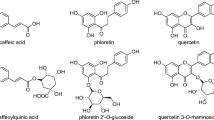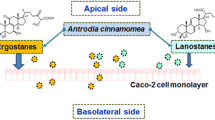Abstract
Phenolic compounds are common ingredients in many dietary supplements and functional foods. However, data concerning physicochemical properties and permeability of polyphenols on the intestinal epithelial cells are scarce. The aims of this study were to determine the experimental partition coefficient (Log P), and parallel artificial membrane permeability assay (PAMPA), to characterize the bi-directional transport of six phenolic compounds viz. caffeic acid, chrysin, gallic acid, quercetin, resveratrol and rutin in Caco-2 cells. The experimental Log P values of six polyphenols were correlated (R 2 = 0.92) well with the calculated Log P values. The apparent permeability (P app) range of all polyphenols in PAMPA for the apical (AP) to basolateral (BL) was 1.18 ± 0.05 × 10−6 to 5.90 ± 0.16 × 10−6 cm/s. The apparent Caco-2 permeability (P app) range for the AP–BL was 0.96 ± 0.03 × 10−6 to 3.80 ± 0.45 × 10−6 cm/s. The efflux ratio of P app (BL → AP) to P app (AP → BL) for all phenolics was <2, suggesting greater permeability in the absorptive direction. Six compounds exhibited strong correlations between Log P and PAMPA/Caco-2 cell monolayer permeation data. Dietary six polyphenols were poorly absorbed through PAMPA and Caco-2 cells, and their transepithelial transports were mainly by passive diffusion.




Similar content being viewed by others
References
Fichert T, Yazdanian M, Proudfoot JR (2003) A structure–permeability study of small drug-like molecules. Bioorg Med Chem Lett 13:719–722
Fresco P, Borges F, Diniz C, Marques MP (2006) New insights on the anticancer properties of dietary polyphenols. Med Res Rev 26:747–766
Han X, Shen T, Lou H (2007) Dietary polyphenols and their biological significance. Int J Mol Sci 8:950–988
Hilgers AR, Conradi RA, Burton PS (1990) Caco-2 cell monolayers as a model for drug transport across the intestinal mucosa. Pharm Res 7:902–910
Hollman PCH, Katan MB (1997) Absorption, metabolism and health effects of dietary flavonoids in man. Biomed Pharmacother 51:305–310
Justesen U, Knuthsen P, Leth T (1998) Quantitative analysis of flavonols, flavones, and flavanones in fruits, vegetables and beverages by high-performance liquid chromatography with photo-diode array and mass spectrometric detection. J Chromatogr A 799:101–110
Kansy M, Senner F, Gubernator K (1998) Physicochemical high throughput screening: parallel artificial membrane permeation assay in the description of passive absorption processes. J Med Chem 26:1007–1010
Kerns EH, Di L, Petusky S, Farris M, Ley R, Jupp P (2004) Combined application of parallel artificial membrane permeability assay and Caco-2 permeability assays in drug discovery. J Pharm Sci 93:1440–1453
Kobayashi S, Nagai T, Konishi Y, Tanabe S, Morimoto K (2012) Transport mechanisms of flavanone aglycones across Caco-2 cell monolayers and artificial PAMPA membranes. J Pharm Pharmacol 64:52–60
Kroon PA, Clifford MN, Crozier A, Day AJ, Donovan JL, Manach C, Williamson G (2004) How should we assess the effects of exposure to dietary polyphenols in vitro? Am J Clin Nutr 80:15–21
Lajiness M, Vieth M, Erickson J (2004) Molecular properties that influence oral drug-like behavior. Curr Opin Drug Discov Devel 7:470–477
Link A, Balaguer F, Goel A (2010) Cancer chemoprevention by dietary polyphenols: promising role for epigenetics. Biochem Pharmacol 80:1771–1792
Lipinski CA (2004) Lead- and drug-like compounds: the rule-of-five revolution. Drug Discov Today Technol 1:337–341
Lipinski CA, Lombardo F, Dominy BW, Feeney PJ (2001) Experimental and computational approaches to estimate solubility and permeability in drug discovery and development settings. Adv Drug Deliv Rev 46:3–26
Liu X, Testa B, Fahr A (2011) Lipophilicity and its relationship with passive drug permeation. Pharm Res 28:962–977
Lotito SB, Frei B (2006) Consumption of flavonoid-rich foods and increased plasma antioxidant capacity in humans: cause, consequence, or epiphenomenon? Free Radic Biol Med 41:1727–1746
Manach C, Williamson G, Morand C, Scalbert A, Remesy C (2005) Bioavailability and bioefficacy of polyphenols in humans. I. Review of 97 bioavailability studies. Am J Clin Nutr 81:230S–242S
Neuhoff S, Ungell AL, Zamora I, Artursson P (2005) pH-dependent passive and active transport of acidic drugs across Caco-2 cell monolayers. Eur J Pharm Sci 25:211–220
Prasain JK, Barnes S (2007) Metabolism and bioavailability of flavonoids in chemoprevention: current analytical strategies and future prospectus. Mol Pharm 4:846–864
Rahman I, Biswas SK, Kirkham PA (2006) Regulation of inflammation and redox signalling by dietary polyphenols. Biochem Pharmacol 72:1439–1452
Refsgaard HHF, Jensen B, Brockhoff P, Padkjr S, Guldbrandt M, Christensen M (2005) In silico prediction of membrane permeability from calculated molecular parameters. J Med Chem 48:805–811
Scalbert A, Williamson G (2000) Dietary intake and bioavailability of polyphenols. J Nutr 130:2073S–2085S
Schieber A, Keller P, Carle R (2001) Determination of phenolic acids and flavonoids of apple and pear by high-performance liquid chromatography. J Chromatogr A 910:265–273
Silberberg M, Morand C, Mathevon T, Besson C, Manach C, Scalbert A, Remesy C (2006) The bioavailability of polyphenols is highly governed by the capacity of the intestine and of the liver to secrete conjugated metabolites. Eur J Nutr 45:88–96
Suzuki H, Sugiyama Y (2000) Role of metabolic enzymes and efflux transporters in the absorption of drugs from the small intestine. Eur J Pharm Sci 12:3–12
Tian XJ, Yang XW, Yang X, Wang K (2009) Studies of intestinal permeability of 36 flavonoids using Caco-2 cell monolayer model. Int J Pharm 367:58–64
van de Waterbeemd H, Gifford E (2003) ADMET in silico modelling: towards prediction paradise? Nat Rev Drug Discov 2:192–204
Veber DF, Johnson SR, Cheng HY, Smith BR, Ward KW, Kopple KD (2002) Molecular properties that influence the oral bioavailability or drugs. J Med Chem 45:2615–2623
Vieth M, Siegel MG, Higgs RE, Watson IA, Robertson DA, Savin KA, Durst GL, Hipskind PA (2004) Characteristic physical properties and structural fragments of marketed drugs. J Med Chem 47:224–232
Wenlock MC, Austin RP, Barton P, Davis AM, Leeson PD (2003) A comparison of physicochemical property profiles of development and marketed oral drugs. J Med Chem 46:1250–1256
Acknowledgments
We thank Sai Advium Life Sciences, India for providing necessary facilities and technical support during this work.
Conflict of interest
The authors have declared that there are no conflicts of interest.
Author information
Authors and Affiliations
Corresponding author
Rights and permissions
About this article
Cite this article
Rastogi, H., Jana, S. Evaluation of physicochemical properties and intestinal permeability of six dietary polyphenols in human intestinal colon adenocarcinoma Caco-2 cells. Eur J Drug Metab Pharmacokinet 41, 33–43 (2016). https://doi.org/10.1007/s13318-014-0234-5
Received:
Accepted:
Published:
Issue Date:
DOI: https://doi.org/10.1007/s13318-014-0234-5




